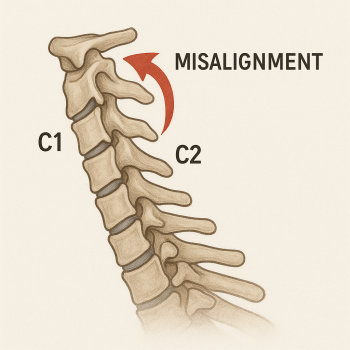
Understanding Tension Headaches
Tension headaches, the most common type of headache, are characterized by a constant, dull, and aching pain that often feels like a tight band around the head. They can last from 30 minutes to several hours, sometimes persisting for days. Unlike migraines, tension headaches do not typically cause nausea or vomiting and are not aggravated by physical activity. Despite being less severe than other types of headaches, they can significantly impact daily life, especially if they become chronic.
The Connection Between Poor Posture and Tension Headaches
Poor posture, particularly when maintained over long periods, can lead to muscle tension and strain, which are significant contributors to tension headaches. Here’s how poor posture affects your body and leads to headaches:
Muscle Strain
When you slouch or hunch over a computer or phone for extended periods, you strain the muscles in your neck, shoulders, and upper back. This strain can create muscle spasms and inflammation, leading to pain that radiates to your head. The muscles in the neck and shoulders become overworked and fatigued, causing discomfort that can develop into a headache.
Spinal Alignment
Proper posture maintains the natural alignment of your spine. Poor posture disrupts this alignment, causing the spine to curve unnaturally. When the spine is misaligned, it can place pressure on the nerves and blood vessels in the neck, leading to headaches. For example, forward head posture, where the head is positioned in front of the shoulders, increases the stress on the cervical spine, leading to neck pain and tension headaches.
Increased Pressure on Joints
Bad posture increases the pressure on the joints in your neck and upper back. Over time, this can cause wear and tear on these joints, leading to chronic pain and headaches. The joints, unable to function properly, become a source of inflammation and discomfort, contributing to the development of tension headaches.
Reduced Oxygen Flow
Poor posture can restrict your breathing, reducing the amount of oxygen that reaches your brain. When your lungs cannot expand fully due to slouched posture, your body receives less oxygen, which can lead to headaches and fatigue. Proper breathing is essential for maintaining optimal brain function and overall well-being.
Recognizing the Signs of Poor Posture
Understanding the signs of poor posture is the first step in correcting it. Common indicators include:
- Rounded shoulders: Shoulders that slump forward and create a curved appearance.
- Forward head position: The head juts forward, out of alignment with the spine.
- Hunched back: The upper back appears rounded or curved.
- Uneven hips: One hip may be higher than the other, indicating an imbalance.
Tips for Improving Posture
Improving your posture can significantly reduce the risk of tension headaches. Here are some practical tips to help you maintain proper posture:
Ergonomic Workspace
Ensure your workspace is ergonomically designed to promote good posture. Your computer screen should be at eye level, and your chair should support your lower back. Adjust your chair so that your feet are flat on the floor and your knees are at a 90-degree angle. Using a standing desk or an adjustable desk can also help you alternate between sitting and standing, reducing strain on your muscles.
Regular Breaks
Taking regular breaks to stand, stretch, and move around is crucial for reducing muscle tension and improving circulation. Aim to take a break every 30 minutes to prevent prolonged periods of poor posture. Simple stretches like neck rolls, shoulder shrugs, and back stretches can alleviate tension and improve your posture.
Strengthening Exercises
Engage in exercises that strengthen your core and back muscles. A strong core provides the necessary support for proper posture. Pilates, yoga, and strength training exercises that focus on the back, abdomen, and pelvis can help improve your posture and reduce the risk of tension headaches.
Mindfulness
Being mindful of your posture throughout the day can help you make necessary adjustments. Regularly check in with yourself to ensure you’re not slouching or hunching over. Use reminders, such as phone alarms or sticky notes, to prompt you to correct your posture. Practicing mindfulness and body awareness techniques, such as tai chi or meditation, can also help you maintain good posture.
Chiropractic Care
Consider visiting a chiropractor for professional help. Chiropractic adjustments can help realign your spine, relieve muscle tension, and improve overall posture. Chiropractors can provide personalized advice and exercises to help you maintain proper posture and prevent tension headaches.
Lifestyle Adjustments for Better Posture
In addition to the tips above, making lifestyle adjustments can help you maintain good posture and prevent tension headaches.
Proper Sleeping Position
Your sleeping position can significantly affect your posture and overall health. Sleeping on your back with a supportive pillow that keeps your head in line with your spine is ideal. Avoid sleeping on your stomach, as it can strain your neck and back. A firm mattress that provides adequate support for your spine is also essential.
Proper Footwear
Wearing supportive footwear is crucial for maintaining proper posture. High heels and shoes without adequate arch support can throw off your balance and posture. Opt for shoes with good arch support and cushioning to help maintain proper alignment.
Healthy Weight
Maintaining a healthy weight can reduce the strain on your muscles and joints, promoting better posture. Excess weight, particularly around the abdomen, can shift your center of gravity and lead to poor posture. A balanced diet and regular exercise can help you maintain a healthy weight and support proper posture.
Conclusion
Poor posture is a significant contributor to tension headaches, but with mindful practices and proper ergonomic adjustments, you can alleviate the strain on your muscles and reduce the frequency of these headaches. Remember, maintaining good posture is not just about looking confident; it’s about ensuring your body’s systems function optimally, preventing pain and discomfort.
By incorporating ergonomic changes, regular breaks, strengthening exercises, and professional chiropractic care into your routine, you can improve your posture and overall well-being. Paying attention to your posture throughout the day and making necessary adjustments can significantly reduce the occurrence of tension headaches and enhance your quality of life.







Leave a comment